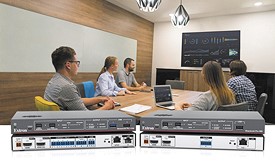Anaheim, California (June 17, 2021) – Extron is pleased to announce that the ShareLink Pro WFA 100 is now shipping. The WFA 100 is a Wi-Fi Miracast adapter that enables anyone to share content from a Windows 10 device to a ShareLink Pro device without installing any software. It connects to the USB port on a ShareLink Pro 1100 or ShareLink Pro 500, making it discoverable to Windows 10 users. Users share content by selecting the desired ShareLink Pro device and mirroring their screen from within Windows. Content shared via Miracast can be presented on the ShareLink Pro display along with content shared via the ShareLink Pro App, Apple mirroring, WebShare browser sharing, or the HDMI input.
“At Extron, we are always looking for more ways to make interacting with AV systems easier, faster, and more intuitive,” says Casey Hall, Vice President of Worldwide Sales and Marketing at Extron. “We are pleased to introduce our new Wi-Fi Miracast adapter so that Windows 10 users can experience a quick and seamless way to share content to ShareLink Pro systems.”
ShareLink Pro devices enable anyone to present wired or wireless content from their computers, tablets, or smartphones onto a display for easy collaboration. They feature streaming technology that supports simultaneous display of up to four devices, including an HDMI-connected device, and dynamically update the display layout as new content is shared or removed. The HDMI input supports wired connections from any connected source in the room. To support a wide range of environments, ShareLink Pro has collaboration and moderator modes that facilitate both open and controlled environments. When used with Extron GVE – GlobalViewer Enterprise software, multiple units can be managed across an enterprise or campus. ShareLink Pro’s professional capabilities provide easy integration of AV and mobile devices into meeting, huddle, collaboration, and presentation spaces.
For more information about the ShareLink Pro WFA 100, click here.
Extron – The AV Technology Leader
Every day, millions of people around the world are having their experiences enhanced by Extron audiovisual signal processing, distribution, and control solutions. We design advanced technologies to create better looking images, higher quality sound, systems that are easier to control and work more reliably. Our powerful asset management tools are helping technology professionals efficiently manage large numbers of audiovisual systems deployed throughout their enterprises and institutions. Extron AV technology solutions serve the diverse needs of organizations around the world and are deployed in a wide variety of corporate, educational, government, healthcare, retail, and entertainment applications.
To learn more about Extron, click here.
Miracast™ is a mark of the Wi-Fi Alliance. Windows® is a registered trademark of Microsoft Corporation. Extron® and ShareLink® are registered trademarks of Extron.

